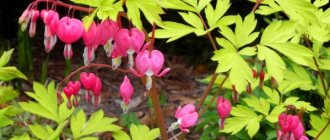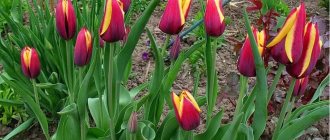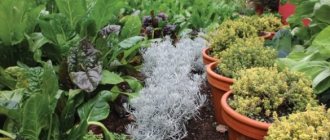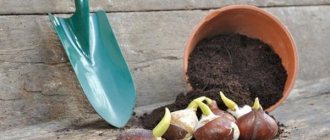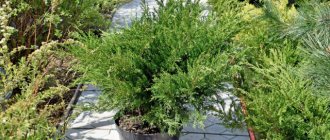Features of autumn planting - pros, cons
Flowers planted in autumn undergo the most natural development cycle, as the planting material is stratified. Seeds and flower bulbs that survive the winter tolerate short spring frosts well, begin flowering a little earlier than others, and cope better with pest invasions and all kinds of diseases.
When planting in late autumn, you don’t have to spend a month or two growing seedlings, and an excellent result - a lush flowerbed - will appear much earlier than in the spring. Perennials planted on the eve of winter harden sufficiently during the cold period and produce shoots, leaves, and flowers faster in the spring. Many beautifully flowering plants bloom most profusely during autumn planting, since they have time to take root in the fall.
Another important argument in favor of planting in the fall is that the gardener can spend more time choosing plants and think about what to plant and where. In addition, autumn soil warmed by the sun is much easier to dig up, and frequent autumn rains make it possible to do practically without “manual” watering.
There are also some disadvantages of winter plantings. During winter and early spring thaws, seeds and plant bulbs can awaken and die with the repeated onset of cold weather. If the planting is not too deep and severe frosts, some of the plantings die, but in the spring this is easy to notice and promptly duplicate in the right places.
Content
- 1. Top popular plants that are planted with seeds in the fall 1.1. Annuals
- 1.2. Perennials
- 2.1. Video: how to properly plant seeds of flowers and herbs before winter
- 3.1. When and how to plant lilies in the fall
Along with harvesting, the main autumn event for gardeners, there is another important activity to be done at this time of year: planting flowers. In this case, from the first days of spring, flower beds, edgings, and mixborders will delight you with beautifully flowering plants. The choice of flowers for planting in the fall is quite large. The main criterion for selecting such flora is high winter hardiness.
It is recommended to protect plants native to the tropics and subtropics from the tests of Russian frosts. It is better to grow them in seedlings and place them in open ground in the spring. By the way, these representatives of the flora in our latitudes are often cultivated as annuals. The most striking example is petunia.
How to prepare the soil in the fall for planting flowers
Autumn soil preparation has its own characteristics:
- the space intended for the flower bed is cleared of weeds, dried tops, and decaying fruits; all plant debris is placed in a compost heap;
- immediately after harvesting, the ground is dug up, stimulating the germination of weeds in the autumn and their death from the first frosts, which will reduce the time for weeding next spring;
- deep digging destroys the habitats of pests, leading to their destruction by cold air;
- the area where planting is planned must be carefully selected and properly arranged so that the seeds are not washed away by melt water and the bulbs do not begin to rot;
- Before planting, the soil is carefully dug up again so that the soil is maximally saturated with oxygen, suitable fertilizers are applied, and furrows are made;
- the earth is dug up to a depth of 15-20 cm, and the lumps are not broken, so that the biologically active water formed when the snow melts is better retained on the uneven area;
- sowing is done in slightly frozen ground, around mid-November or in December, directly into the snow if its layer reaches 20-30 cm. In both cases, the planting is sprinkled with a mixture of sand and peat, humus, sand and compost.
Flower pruning
In October, almost all the flowers have already bloomed, so perennials such as rudbeckia, scabiosa, yarrow, aster, astilbe, paniculate phlox, echinacea, spurge, peony, delphinium, monarda, goldenrod, gypsophila, columbine, cornflower, bellflower, coreopsis, lily of the valley , liatris, lily and linchis, cut off all the leaves and stems, leaving only stumps up to 3 cm high above the surface. Then the plantings of these flowers are mulched with compost or sprinkled with dry garden soil.
Weak thin shoots are cut out on rose bushes, leaves are removed, and the stems are hilled. Hydrangeas and clematis are also subjected to sanitary and thinning pruning.
Choosing a planting site, planning a flower garden
Professional flower growers choose the location for the future flower bed in advance. It is placed:
- along the paths;
- in the front garden;
- near the terrace;
- along the edges of lawns;
- near the fence.
The length of the flower bed has practically no restrictions, its convenient width is 100-300 cm, the configuration is adjusted to the shape of the site. Usually a flowerbed is “tied” to one of the large objects - a path, veranda, gazebo, etc. The contours and dimensions are measured with a tape measure, marked with a rope tied to pegs, in increments of 50-70 cm. The flowerbed itself is made ordinary or raised, looks like a mixboard or ridges, shady flower garden or “rock garden”.
The composition of the flowerbed is also taken into account: if the place under it is in the sun for more than six hours a day, then only sun-loving plants are planted here; when the sun's rays fall on the space of the future flowerbed for less than three hours a day, the most shade-tolerant ones will do. Usually, plants that bloom at different times are planted within the same flowerbed - then the flower garden will look beautiful from early spring to late autumn. Low-growing flowers are placed closer to the edges of the flowerbed, and taller flowers are placed in the middle.
It is also important to choose plants by color - a flower garden made in one color does not look very beautiful. The best combinations are blue delphinium with yellow lilies, giant purple onions with white and yellow daffodils, purple and yellow aquilegias, orange marigolds with blue sage, hellenium with yellow rudbeckia, etc.
In order for the plantings to bloom in the coming spring, it is recommended to choose express varieties.
When to divide perennials
You can determine that plants need replanting by looking at the “bald” center of the bush. If flowering has become scarce and the flowers have become smaller. As a rule, dividing perennials is carried out every five to six years. Experienced gardeners annually rejuvenate, divide or replant two or three perennials in the flowerbed. Thus, the overall decorative effect of the flower garden is not disturbed.
Dividing the bush and replanting perennials is carried out in early spring, before foliage grows, and in the fall, a month and a half before a steady cold snap. Perennial flowers that bloom in late summer and fall are replanted in the spring. So that before flowering they have time to take root, recover and bloom in due time.
In the fall, perennials that have bloomed in the spring and early summer are replanted. Before the cold weather, they must take root in a new place and get stronger, preparing for winter.
Perennial flowers that are replanted in early autumn
In September, the unpretentious astilbe, this beauty of the shady garden, is replanted. However, this plant easily tolerates transplantation at any phase of the growing season. Brunnera, herbaceous peony, delphiniums and lupins are planted and divided in early autumn. Transplanted hostas, irises, clematis, and phlox take root well at this time.
As a rule, new varieties of these plant species can be planted at the same time.
Planting bulbous plants in autumn
It makes sense to plant flowers grown from bulbs in the fall. It is important to choose your planting time carefully. If planted too early, when the weather is still warm for a month or more, the flowers will begin to sprout and die from the first frost. If planted too late, the bulbs will not have time to take root well, which will also lead to death from sharp frosts.
Of the bulbous plants that winter most successfully:
- tulip;
- hyacinth;
- crocus;
- narcissus;
- lily;
- Colchicum;
- Pushkinia;
- Chionodox;
- Muscari.
Bulbous flowers intended for winter planting are placed in the soil so that the layer of soil above the bulbs is 2.5-3.5 times thicker than the bulbs themselves.
Crocuses
Crocus or saffron is a bulbous plant that blooms fabulously brightly. Richly colored flowers appear in March-May. Sunny areas (diffused shade is acceptable) and the loosest, most permeable soils are suitable for planting. Spring-blooming crocuses are planted in September or October, choosing bulbs that have not sprouted, are dense and do not have any damage. The latter are able to withstand frosts down to -17-19 degrees, but the larger the planting material, the deeper it is buried.
Hyacinths
Hyacinth is an early spring flower that loves bright sun and flower beds that are never touched by cold winds. Planting is carried out in the first ten days of October, in not too wet soil, since the bulbs can easily rot. If the autumn turns out to be very warm, planting is postponed until early November, since if it is too early, the plant will “grow” and die when cold weather sets in. But it also makes no sense to plant in frozen soil - the flower will not have time to take root.
Tulips
The tulip is rightfully considered the king of spring flower beds. This is a bulbous flower, of which there are hundreds of species, varieties, and thousands of color options. Planting takes place in mid-September - early October, when the air temperature is no higher than +6-11 degrees. The tulip blooms in mid-April - early June, prefers loose, well-drained soil, sunny places where there is no wind and stagnant moisture. The distance from bulb to bulb is approximately 10 cm, between rows - 20-25 cm. Several varieties that bloom at different times are often placed in one flowerbed at the same time.
Daffodils
Daffodils love the sun, but are afraid of cold winds; in the middle zone they bloom in April or May. These perennials have more than two thousand varieties, some of which can grow in partial shade, but bloom most beautifully in the sun. Bulbs are planted in open ground in September. Daffodils are very moisture-loving; loamy soil is optimal for them. The recommended distance between individual bulbs is about 15 cm.
Daffodils are planted only in autumn; spring plantings are not allowed.
Lilies
Lilies look luxurious, very elegant, and have different colors. They bloom in June-August; it is better to grow them in sunny places, in loose, fertile, well-drained soil. Planting, replanting, and dividing bushes is carried out in mid-September - early November, at an air temperature of no more than +10 degrees. The bulbs need to be planted in holes with coarse wet sand, at a distance of at least 15 cm from each other. For the winter, the flower is covered with oak foliage so that it does not rot.
In the fall, only fresh bulbs that are grown and dug up are replanted. It makes sense to plant store-bought material only in the spring.
Colchicum
Colchicum, growing in the middle zone, is unpretentious and has a huge variety of varieties. Up to 20 species are grown in the gardens, blooming in spring or autumn. The flower is poisonous when eaten by pests and can cause harm to pets and humans. Autumn varieties, the dormant period of which falls in the summer, are planted in the first ten days of September, less often - at the very end of August. Small bulbs are embedded in the ground no deeper than 7-8 cm, the largest ones - 10-12 cm.
Iridodictiums or iris
Iris reticulum or iridodictium is a bulbous perennial. It is planted at the very end of September, but not earlier, so that the flower “takes hold”, has time to adapt a little, but does not germinate. Flowering begins a couple of weeks after the snow has completely melted and ends by June. The flowers reach a size of five to eight cm in diameter, they are very fragrant, colored yellow with specks, pale blue, reddish-violet, lilac. The bulbs are covered with a kind of mesh and actively divide during the growth process, producing many “babies”.
Muscari
Muscari, “viper onion”, “mouse hyacinth” are different names for the same flower, painted in blue tones. The plant is unpretentious, easily takes root in both sunny and shady areas, but the soil under it must be well drained; stagnation of moisture is dangerous. The best time to plant muscari in the fall is from mid-September to mid-October. The flowering period is April-May, if the year is cold - two to three weeks later.
Pushkinia
Miniature Pushkinia or “dwarf hyacinth” has a pastel blue color of inflorescences, as if made of tissue paper. The first shoots sprout from the ground in early to mid-March, as soon as the snow melts, after another ten days the buds begin to form, and flowering ends by May. Its duration depends on the average ambient temperature, amounting to approximately three to four weeks.
Pushkinia loves sunny places, but, as a last resort, sparse shade will do. The growing season of the flower occurs in spring, when there are no leaves on the trees yet - almost nothing obscures the sun. It is recommended to plant Pushkinia in loose soil, where water does not linger too much. Before planting, the soil must be fertilized with manure, humus, wood ash, and mineral additives. The bulbs are planted at the end of September, well covered with soil.
Chionodox
There are only six species of low-growing perennial Chionidoxa. This same plant is called “snow beauty”, since the bush germinates at the same time as snowdrops - when the snow has just melted. It is advisable to plant flower bulbs at the very beginning of autumn, when the root ridges are fully formed in their lower part. The place chosen is brightly lit or slightly shaded by trees and bushes, best of all - on hills where the snow will melt first. Bulbs planted in lowlands and shade will bloom later, but this period will be longer.
Chionidoxes are planted in nutritious, loose, well-moistened soil, neutral or slightly alkaline, to which humus and crushed tree bark are added. The depth directly depends on the size of the bulbs - the larger they are, the greater the layer of earth placed on top. The distance between plants is 9-11 cm.
When is the best time to replant perennials?
Transplantation and propagation by dividing rhizomes is carried out in spring or autumn:
- In the first case, plants best tolerate the procedure carried out from the second half of April to the first days of May.
- The second time it is possible to move the perennials to a new location from August to September.
The choice of one option or another depends on the planted crop. It is better to replant plants that bloom in the second half of summer with the onset of warm weather, and, conversely, when buds appear in the spring, replanting is postponed until autumn.
Many gardeners prefer to devote the end of summer and beginning of autumn to caring for perennials for the simplest and most obvious reason. During this period, they have more free time for such pleasant, but rather troublesome work.
However, experienced flower growers associate serious risks with autumn transplantation. If you are a little late, then perennials that did not take root again before the cold weather may suffer in winter or even die. Therefore, the procedure is always consistent with the long-term weather forecast, taking into account the frost resistance of crops and the climatic characteristics of the region. It is better if during transplantation there is dry weather with an air temperature of at least 12–15 degrees.
Flowering perennials for fall planting
Blooming perennial flowers are also often planted in the fall in a variety of ways. From early September to early November plant:
- perennial cornflower;
- geranium;
- astilbe;
- Iberis;
- aquilegia;
- periwinkle;
- bought;
- loosestrife;
- Brunner;
- loosestrife;
- perennial phlox;
- lupine;
- doronicum;
- swimsuit;
- meadowsweet;
- perennial aster;
- herbaceous peony;
- to the host.
Aquilegia
Biennial, unpretentious in terms of care and a very interesting plant, has several names - orlik, columbine. Flowering times may vary depending on the variety, but for many it begins in early June. Planting aquilegia in the fall is done by sowing seeds. It is optimal to grow in moist, loose, fertile, light soil. It is possible to grow in the sun, but the plant will be most comfortable in partial shade.
Astilbe
A beautiful, unpretentious perennial. At the same time, delicate, bright astilbes can decorate any area. The color of the flowers can be pink, white, purple, red. Summer flowering dates vary from June to August. The best time to plant a flower in the fall is early September. If you plant astilbe at a later date, it is imperative to mulch and cover it before winter. Before the event, the soil is dug up, weeds are removed, and fertilizing with rotted manure is carried out. After autumn planting, it is advisable to mulch the astilbe; for this, sawdust and straw are usually used.
Periwinkle
Periwinkles can take root on any soil, as well as on the slopes of a summer cottage. The subshrub blooms blue and grows quickly in sun and partial shade. Plants are planted 32-40 cm from each other, propagated by seeds, layering, cuttings, and dividing the bush. The latter option is suitable for both spring and autumn, as the flower takes root quickly. At first, watering is necessary, but in the future the mature plant gets by just fine with the moisture that is in the ground.
Brunner
The plant is beautiful, unpretentious, and is usually planted along paths, fences, in flower beds and alpine hills. The flower loves moisture and shade, blooms in April-May, and re-blooming is sometimes observed in warm summers. Brunnera is planted and replanted in the first half of September; if later, it needs to be earthed up. Planting is carried out in the evening, in moist, fertile soil.
Perennial cornflower
This herbaceous plant has bright blue flowers with a characteristic shape. The perennial grows well for up to 10-12 years in the same place, but every four to five years it is advisable to “rejuvenate” it. Reproduction is carried out by dividing the bush - they dig up the roots, trim them so that new ones begin to form. The bush is divided into viable parts that have roots and shoots, planted in holes, and watered. At the beginning of summer the plant will already bloom. They are also grown from seeds - when sowing in autumn, it is carried out in October, there is no need to use shelter for this.
Loosestrife point
Loosestrife has bright yellow flowers that bloom in June and fade in August. The plant grows quickly, so replanting is done every three years, in September-early November, but it is not too cold yet. Both well-lit and sparsely shady places are suitable for replanting; the soil is moistened in advance and complex fertilizers are applied. It is important that the plant does not have young leaves that can immediately begin to grow.
Geranium
Garden geranium is very unpretentious. This perennial flower is able to grow on sandy, peaty, clay soil, but prefers “black” meadow soil, rich in humus or loamy soil. The tops of geraniums pruned in autumn are well received - this is the main difference from winter ones. They begin to bloom in the first summer after planting, and grown from seeds - a year later. Planting is done at the end of September in moist soil, slightly compacting it.
Loosestrife
Derbennik is a garden flower, which is sometimes called “weeping grass.” It blooms all summer, pink or purple, forming thickets two meters high, decorated with “panicles”. Merlin loves water and sun, it is very frost-resistant, prefers fertile garden soil. Fertilizer for it is selected with a high nitrogen content; mulching and timely pruning (once a year) are also necessary.
Doronicum
Doronicum, also known as “sunny daisy”, “kozyulnik”, blooms twice in the hot summer. It is planted in the sunniest places, sown at the end of September, but spring cultivation of seedlings in greenhouses is also acceptable. Reproduction is also possible by dividing rhizomes or cutting them - the procedure is performed in September-early October. Planting material is placed in moist, well-fertilized soil.
Swimsuit
The swimsuit has more than 20 varieties, all of them have bright, double flowers, six to eight cm in diameter. The first shoots appear from the ground in April, by May flowering begins, which lasts 18-25 days, the fruits ripen in June. The best time for planting is October. It is better to purchase “store-bought” seeds, since a maximum of 50-70% of those grown independently will sprout. Sow the swimsuits in a garden bed or in a box, the seed material is lightly sprinkled with earth.
Kupena
Other names for kupena are “wolf grass”, “magpie eye”, “Solomon’s seal”, hernia grass, etc. The plant is poisonous, but is used for medicinal purposes; it looks like a lily of the valley. Kupena is planted in open ground from late August to early October. For these purposes, seedlings are usually purchased, since growing from seeds is not very effective and takes a lot of time. Subsequent propagation is carried out by dividing the rhizomes. It is better to plant in partial shade, shade; in the sun, the kupena grows poorly and looks “stunted”. The soil composition is preferably neutral or slightly acidic.
Meadowsweet
Meadowsweet has very decorative flowers and leaves, and grows in one place for up to 7-9 years. It is very moisture-loving, so it is recommended to plant it along the banks of reservoirs, in slightly marshy areas. Meadowsweet is cold-resistant; it is propagated by dividing the rhizome in October - the first ten days of November. “Delenki” are recommended to be planted at a distance from each other and between rows of 32-38 cm, in moist, fertile, well-dug soil.
Lupine
Lupine is suitable for gardeners who love beautiful, most unpretentious plants. Lupine flowers are purple, creamy white, white with purple, pink, and less often red or yellow. The plant is sun-loving and thrives both on humus-rich and sandier soils. Seeds are sown in moist soil in October-November, transplantation is carried out in September, when the air temperature is more than +10-12 degrees.
perennial aster
Perennial asters are colored white, yellow, cream, purple, bluish-lilac, etc. A flowerbed decorated with such flowers looks lush, elegant, “rainbow-like.” Flowering, depending on the variety and species, occurs in May-June, July-September, October-November. Plantings are carried out from mid-November to the first ten days of December, in slightly frozen soil. Sunny areas or sparse shade are selected, but too dark corners are unacceptable.
It is not advisable to plant asters in places where there is stagnant water, since the roots there often rot and the plant dies.
herbaceous peony
The herbaceous peony blooms in spring, takes root well in sunny places, near bushes, barriers that can protect the plant from the wind. Excessively waterlogged lowlands are unacceptable. Planting is carried out in early September, in a hot year - a week or two later. To plant a whole bush, you will need a hole 90 cm wide and up to 70 cm deep. Drainage, phosphorus-potassium fertilizer, and a little humus are placed at the bottom. During the first winter, a shelter must be provided.
Phlox perennial
Phlox is a very decorative perennial that blooms beautifully in summer. It is planted in a place with maximum sun exposure, in loose, moist, fertile soil. Reproduction by seeds and division of rhizomes is allowed. The last procedure is performed in September. When planting later, mulching is done with dry leaves, grass, wood chips, and special covering material.
Hosts
Hosta is rightfully considered the “queen of the shade”, since it grows, blooms, and has a decorative appearance best in shaded places - under dense tree crowns, near fences, outbuildings, etc. Moist, but not swampy soils are optimal. Hosta blooms profusely on fertile soil and fades by mid-summer. Transplantation is preferable in October - at least a month before frost hits.
Autumn sowing rules
For sowing to be successful, you must adhere to the following rules. The key to flowers being accepted is:
- correct selection and preparation of the site;
- flower bed formation;
- planting plants.
The first step is to dig up the soil in the place where the flowers are planned to be planted and level it with a rake. Then the grooves are made. In order for the flowering carpet to feel good in the spring and not rot from excess moisture from melted snow, it is recommended to choose flat areas.
Then the soil must be fertilized so that the plants develop a root system and overwinter without problems. It should also be remembered that tall flowers will look best in the center of the composition and will not interfere with the surrounding green, shorter “neighbors”.
In autumn, nitrogen-containing fertilizers are not applied, as they stimulate the growth of the upper part of the plants.
The distance between the bulbs should not be less than 4-5 cm, and the planting depth is usually 2-3 times the size of the bulb itself. If seeds are sown, it is done more densely than in the spring.
Half an hour before planting, it is recommended to keep the seedlings in a solution of karbofos. After this, dip the bulbs in a solution of potassium permanganate, which is diluted to a pale pink concentration. Each treatment procedure lasts 30 minutes.
Immediately before immersion in the soil, seeds and flower heads are sorted for the presence of diseased or defective specimens. If there is a dark spot or damage on the bulb, then such planting material is thrown away.
If dacha work on the ground occurs in September-October, then the furrows for the seeds are watered. After planting, the beds must be thoroughly trampled and soaked with water.
Plants that bloom in summer can be planted 7-14 days before the onset of frost.
Annual flowers for planting in autumn by seeds
In the fall, it is also permissible to sow annuals, choosing exclusively frost-resistant species, one of the features of which is propagation by self-seeding. Best suited:
- forget-me-not;
- aster;
- Turkish cloves;
- mallow;
- annual phlox;
- Snapdragon;
- calendula;
- petunia;
- fragrant tobacco.
Asters
These unpretentious cold-resistant perennials are planted in the ground in November and carefully thinned out in the spring. Asters planted at the specified time are most resistant to attacks by pests, diseases, and sudden temperature changes. Planting is done in the sunniest places, the soil composition is compost, humus, and a little sand. Before starting the procedure, the soil is loosened to a depth of 10 cm. Flowering occurs in August-October.
From the beginning of spring until frost, the aster is fed three times.
Forget-me-not
Forget-me-not is considered a biennial, since in the third year its decorativeness decreases and the inflorescences become much smaller. Flowering occurs from early May to the second decade of June. It is permissible to grow forget-me-nots in brightly lit or partially shaded places - the second option is preferable. Seeds are sown in moist, loose soil, pre-fertilized with superphosphate, potassium chloride, nitrate, in mid-late October. It is advisable to mulch with dry peat and cover for the winter.
Mallow
Autumn plantings of mallow or hollyhocks look most decorative near fences and are used as a “hedge.” The height of the plant is about one meter, but there are also taller species. Double flowers - almost any color. Seeds are sown in September (but no later than the first ten days of October), less often in March, with autumn transplantation to permanent places. Mallow prefers sunny, but not windy places, fertile, light, not too wet soil. It is also permissible to plant in partial shade, but the flower will grow slowly.
Phlox annual
Annual phloxes are unpretentious; it is only important to take good care of the seedlings. Flowering occurs from mid-June to the end of November, the flowers themselves are white, bluish, bright blue, beige-pink, peach, coffee-colored, etc. The seeds are sown no earlier than mid-November so that they do not have time to germinate while it is still warm. The plantings are covered with fallen leaves, with the first snow on top. It is permissible to sow phlox directly into compacted snow, sprinkle with soil and a thick layer of the first snowball. The first buds will then appear 20-30 days earlier than those sown in the spring.
Turkish clove
Garden carnations are painted in different colors - white, pink, red, burgundy, in two colors at once. The flower smells pleasant and is sown in mid-October only in dry soil. The seeds are buried to a depth of at least one to one and a half cm. They are mulched on top with peat, humus, grass, etc. Turkish carnation blooms in mid-summer, in fertile areas the flowers will be brighter, larger, it is permissible to plant them both in the sun and in partial shade.
Snapdragon
Snapdragon is sown in the ground just before winter, it blooms the next year in July, and fades at the end of October. The plant prefers sunny places and tolerates partial shade. It needs loamy, light, pre-fertilized soil with medium acidity, dug up to 30-35 cm in advance. Propagated by seeds and cuttings. The color of the flowers is yellow, white-yellow, reddish, pink, red, and there are also tricolor species.
Sweet tobacco
Fragrant tobacco looks like a delicate, very decorative plant, painted in different colors - white, pinkish, pale blue with splashes, lilac, etc. Its height is up to 90 cm. The flower often propagates by self-seeding, germinates in early spring, and blooms in June-July. Tobacco is unpretentious, capable of growing and developing both in the sun and in partial shade, and smells especially strongly in the evening. The planting site is chosen to be sunny and protected from the wind.
Calendula
Calendula, also known as marigold, is a herbaceous annual that blooms yellow or orange. Planting is carried out in October, in small piles, the distance between which is 20-25 cm, it is recommended to deepen it by three cm. In the spring, the seedlings are thinned out, transplanting some of the sprouts to another place. You can sow both in a flowerbed and in the rows of the garden, in the sun or in partial shade.
Double and non-double species should not be planted side by side, as they cross-pollinate, losing their decorative properties.
Petunia
Propagated by cuttings, suitable for indoor keeping, with proper care it can survive the winter in the ground. The plant blooms in purple-blue, pink, white, and bright red. Petunia is unpretentious and grows best in light soils and sunny places until mid-October. The soil is first dug up, leveled, and can be sown both in the soil and in the first snow. Seeds should not be allowed to begin development in the fall.
Work in the flower garden in October: planting, digging, replanting
Everyone knows the saying: “Get your sleigh ready in the summer.” Autumn for a florist is “summer”. An experienced housewife knows well that she needs to start preparing for spring in the fall. In order for the garden to be pleasing to the eye next year, some work must be done.
In October we dig up gladioli and dahlias. We dig up gladioli bulbs before the first frost. The leaves should still be green. After digging, we do not cut them off immediately. The leaves contain many nutrients. Place the plants in a dry, ventilated room and wait for the foliage to dry completely. After this, we remove the bottom from the bottom of the bulb and trim the leaves, leaving a stump of up to 7 cm. Store in a dry, frost-free, dark place until spring.
Dig up dahlias as soon as you see blackened and frost-damaged leaves in the morning. It is best to dig up the tubers in the morning so that they can dry in the wind until the evening. We cut off the green mass, leaving stumps of about 10 - 12 cm. Shake the dug up tubers off the ground and wash them in water. We inspect for the presence of rot. If they are, be sure to cut off this area with a sharp, disinfected knife. Dry the cut a little and grease it with brilliant green. We send everything to dry, then put it away for storage.
Photo: Dahlias in October.
We dig up the tuberous begonia from the ground and move it indoors.
Canna is a capricious friend; after digging, you need to wait until the foliage is completely dry. As in the case of gladioli, we inspect the roots for the presence of rot and only after that we put it in sand or sawdust for winter storage.
We also dig up the acidanthera and montrebium, dry it a little and put it in boxes for storage.
We trim, mulch and prepare perennial plants for shelter: roses, hydrangeas, clematis. We cut off all the flowers and buds of roses. We remove thin, green, immature shoots and all leaves from the plant.
Photo: Rose in the garden in autumn.
Also in need of pruning: yarrow, rudbeckia, phlox, monarda, peonies, liatris, lychnis, scabiosa, echinacea, astilbe, kareopsis, bells, lilies. We trim the plants, leaving a stump 3–7 cm long above the ground surface.
Photo: Echinacea in autumn.
Sprinkling indoor plants
To prevent indoor plants from getting sick less and not being affected by pests, they need a warm shower once a month. It does not replace air humidification and spraying, which are preferably carried out during the heating season, but it is an excellent complement.
It is convenient to water plants with wide, hard leaves from the shower by placing a flower pot in the bath. For specimens with sessile (without petioles) foliage, after sprinkling, be sure to remove water from the leaf axils using a paper napkin. Saintpaulias, episcias and other plants with delicate pubescent foliage are washed so that water does not get into the center of the rosette: tilt the pot and rinse each leaf separately with warm water.
Caring for flowers after flowering
Reliable cover with compost or peat is necessary for the winter for helenium and bearded irises, whose roots protrude from the ground. Be sure to mulch with compost or peat the areas with the perennials that you planted this fall, and lay spruce branches on top of the mulch to protect the plants that do not yet have a root system.
Small-bulbous muscari, crocuses, pushkinias, white-flowered and checkerboard hazel grouse, snowdrops and scillas are not covered for the winter - they are cold-resistant enough to overwinter only under a layer of peat mulch, a mixture of earth, humus, compost and peat, or just garden soil. But Dutch bulbs - tulips, lilies and daffodils - are covered with spruce branches on top of the mulch, on which they throw a film, and on top of it - cut tops of perennials or dry grass. Such a shelter protects the bulbs not only from frost, but also from rodents.
Because of rodents, bulbs overwintering in the garden should not be covered with straw. In general, perennials are covered towards the end of October, when cold weather sets in.
Panicle phlox are covered with a bucket of dry soil mixed with humus, and this will be enough for a good winter and abundant flowering next year. There is no need to cut the phlox stems; leave them under a layer of soil with humus - it will be easier to detect them in the spring. Old peony bushes pruned for the winter should be sprinkled with dry soil, but young peonies need not be covered with anything.
The bases of honeysuckle, hydrangea and clematis bushes are also covered with soil, dry leaves or peat, the shoots are removed from the supports and laid on the ground without shelter - winter snow will be enough.
Aconite, goldenrod, doronicum, speedwell, sedum, many-flowered and cypress spurges, species geraniums, daylilies and perennial cornflowers overwinter without any shelter at all.
In October, the soil is also mulched around ornamental shrubs and trees, using humus.
In October, climbing roses are piled high with earth, removed from their supports and bent to the ground. Please note that it may take you time to lay the lignified branches of an adult bush, since they bend the bush to the ground in stages: they tilt it until the branches offer resistance, and in this position they fix the bush, after a day or two they repeat the attempt to tilt the bush as much as possible. the plant will allow it, and again the position is fixed - and so on until the bush lies on a bed of spruce branches. Climbing roses need to be covered when the real cold sets in - in November.

